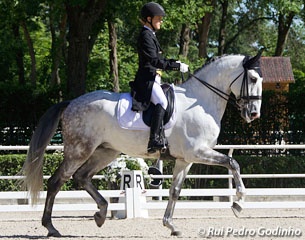
Generalisations are made to fit the majority. In dressage training generalisations can be quite often frustrating or counter productive, as riders try to achieve something that is theoretically suppose to happen a certain way, but unfortunately it just doesn’t. I was reading an article one day about training Lusitanos based on a generalised way Lusitanos move and react to aids and felt it was all wrong. Of course there are Lusitanos, mine included, that don’t fit that norm at all, and training them as such would be rather interesting.
For example my mum's Lusitano when first asked to piaffe naturally went above the rhythm, as he tends to have natural tension when asked these sort of exercises. Batialo on the other hand doesn’t naturally “jig jog” or get tense so his natural piaffe rhythm is slightly too slow. Because of this difference the approach to training the piaffe is very different.
You might own a thoroughbred who feels more like a warmblood, or a pony that thinks he is a Fresian. Every top rider or trainer that I have ever interviewed says that the key to training is to train each horse according to that horse's unique set of physical and mental characteristics.
It gave me the idea to address the alternatives to the norm in my Classical Training articles; what to do with the A-typical horse when faced with different movements, and how to tell what type of method applies to your horse and when.
Starting with the flying changes, Eurodressage received feedback from a reader who said that her TB ex-race horse was having trouble with the flying changes as her canter stride was naturally quite small and while the singles changes were ok, once she got down to the tempis the horse would get tense and boil over.
Flying changes are a very personal thing between horse and rider. You’ll notice that often in the master classes when a top rider is asked to swap horses the flying changes are often the thing that gets mucked up. Nuno Oliveira used to say that you can teach a horse to do flying changes by touching his right ear if you want to, it’s just a case of getting the horse to remember that aid and doing the change willingly.
I have a smaller Lusitano who gets quite nervous in the changes. A horse that, when asked to start the tempi's, would get rather hot and often work himself into a tizz before I’d even started. The first thing to remember when you have a horse that gets wound up, is to reward for the slightest improvement, and never ask more than what is good. This means if you know he gets nervous doing one change and the canter changes after that change, i.e. becomes faster, loses balance, then you must work only on improving that single change before you ask for another. He must know that changes are easy and relaxed, and there is nothing to worry about.
Only when that is like clock work do you ask for more. The minute he gets tense you go back to the one, or even to the canter walk and begin again. This may seem tedious, but if you want good changes, you just have to be patient. I spent a year just doing single flying changes with Batialo, and six months just doing walk to canter, canter to walk.
Then you have to think about the aid. If you touch your horse with your leg back and he gets nervous, fast, or kicks out, you have to think about changing the aid to find one that is comfortable for him In a clinic in Portugal with Miguel Ralao and Daniel Pinto, Portuguese rider Frederico Pinteus was on a horse that was getting faster and more nervous during the two and one time changes. The instructors together had to help design a way to encourage the horse to change without disturbing his balance and relaxation. They discovered that if Frederico touched with his leg forward from the girth and then very quickly got that leg away towards the front, he could touch quickly and light enough so that the horse could keep the rhythm and not get nervous. While he looked slightly like a cowboy it worked a charm and gradually the horse was able to relax in the changes, knowing that he would not be touched in his more sensitive flank area.
Frederico stated that “When you are working with the “exception” you must have a very open mind and try a number different aids, often ones that may seem illogical or unusual.” In just five months the horse above is confident doing one tempi changes and can complete the Grand Prix sequence easily.
Too often we try to achieve things on our horse that we very quickly find to be just not possible. Either we are not capable, or our horse is just not built that way. Being inventive is part of training and if your horse constantly tells you that something is not right, chances are he is the exception to the rule. You just have to throw out that rule book and find a way that works.
by Sarah Warne - Photo © Rui Pedro Godinho
Sarah Warne's Classical Training Articles